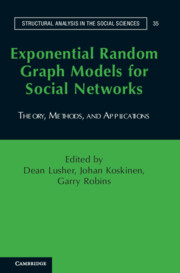22 - Modeling Social Networks: Next Steps
Published online by Cambridge University Press: 05 April 2013
Summary
In this final chapter, we review the progress made in modeling social networks using exponential random graph models (ERGMs) and identify some important questions that remain to be addressed, along with possible ways of approaching them. We also consider the development of ERGMs in the context of broader modeling developments for social networks.
Distinctive Features of ERGMs
As the preceding chapters demonstrate, ERGMs offer four features that are likely to be attractive to social scientists who are interested in deepening our understanding of social networks and the social processes associated with them.
First, and perhaps most important, ERGMs conceptualize social networks as the outcome of social processes that are dynamic, interactive, and local. They are therefore well aligned with many contemporary theoretical views about the evolution of social networks (e.g., Emirbayer, 1997), even though there are a variety of distinct views about the precise social mechanisms involved (e.g., Jackson, 2008; Pattison, Robins, & Kashima, 2008; Rivera, Soderstrom, & Uzzi, 2010; Snijders, 2006). ERGMs give expression to propositions about the outcomes of the dynamic, interactive, local processes that drive network formation and allow us to quantify and assess the observable regularities in social network structure implied by these propositions. Moreover, these assessments are set within a clear statistical framework. Even though there may not necessarily be a fine-grained match between hypothesized theoretical mechanisms and the form of an ERGM, or the means to explore model assumptions in detail (as we discuss later in the chapter), ERGMs nonetheless provide a valuable new capacity to demonstrate potential links between hypothesized network processes and observable network regularities. In brief, they provide social scientists with access to a statistical approach for exploring regularities in social networks and describing these regularities with greater precision.
- Type
- Chapter
- Information
- Exponential Random Graph Models for Social NetworksTheory, Methods, and Applications, pp. 287 - 302Publisher: Cambridge University PressPrint publication year: 2012
- 6
- Cited by



